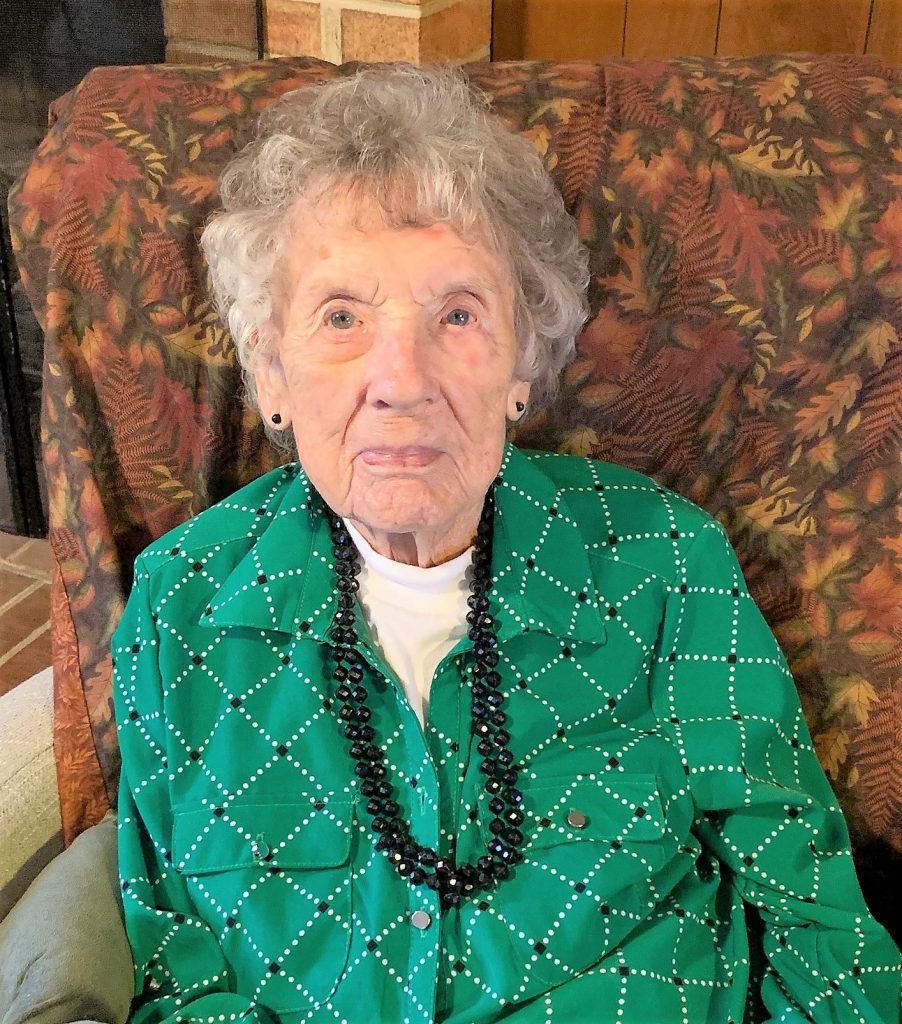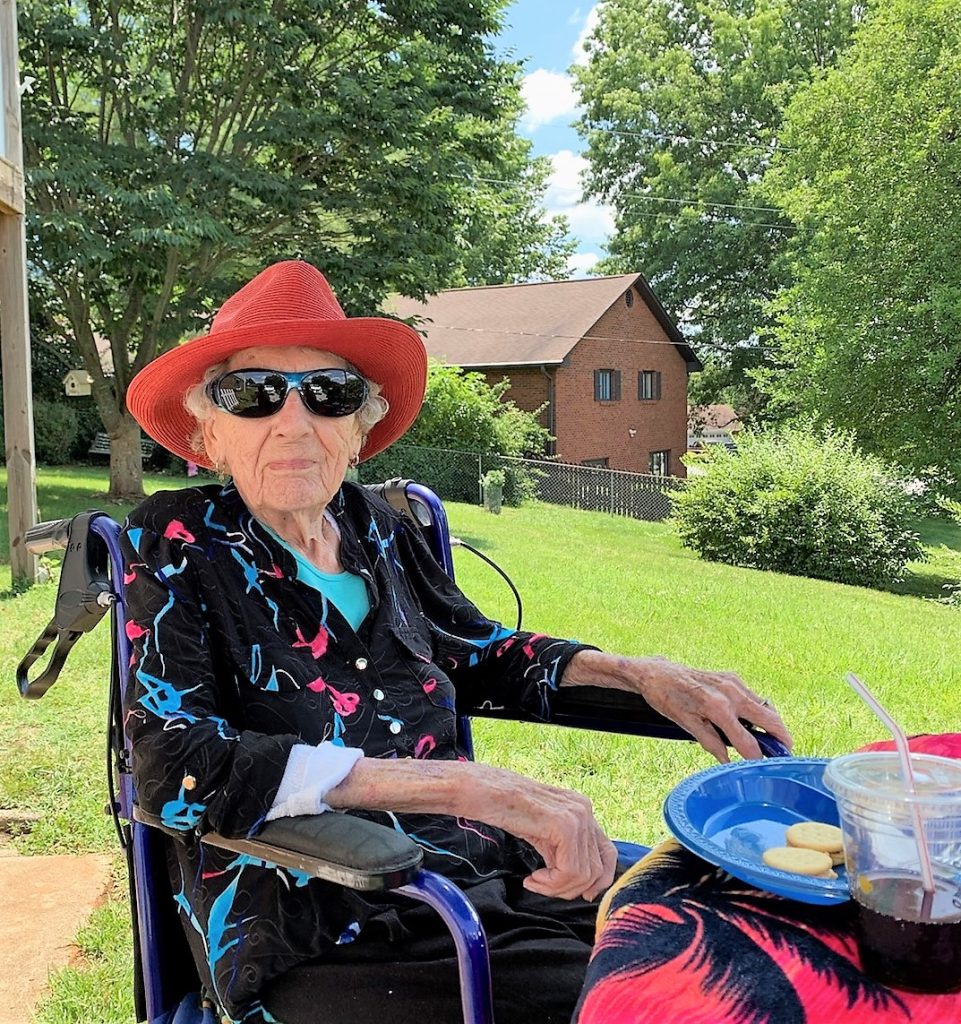By Debbie Adams
Janelle Keesling Hamric celebrated her 105th birthday on August 18. She was born in 1916 and spent most of her life in the small community of Sugar Grove located near Marion in Southwest Virginia. Hamric moved to Vinton this past May to live with her nephew and his wife, Don and Carol Beville.

Her parents, Charles and Donna Hamm Keesling, also grew up in Sugar Grove as did her husband, Herbert. Hamric says she knew him most of her life and although they weren’t exactly childhood sweethearts, “he was a good man, and I didn’t let him get away.”
She was a toddler during the Spanish influenza pandemic of 1918. She was too young to remember the experience, but her mother told her about what a “bad, sad time” it was and, at its peak, seeing mourners coming down from the cemetery while other families were going up for burials.
Hamric does remember the polio epidemic of 1950, which left her husband’s niece and nephew crippled from the disease. She recalls nearby Wytheville as the epicenter of the epidemic and everyone cutting a wide swath around the town for fear of being exposed. She remembers the mass community administration of oral polio vaccines in sugar cubes, which virtually stopped polio in its tracks.
Now Hamric has survived another pandemic with COVID-19 in the past 18 months, with its masks, social distancing, and isolation. She did not hesitate to be vaccinated for COVID in recent months, took the Pfizer vaccine, had some mild side effects with the second dose, but says getting it was simply “the right thing to do.”
Hamric says the passion of her life has been music. She grew up in a musical family. Her mother played the pump organ and piano and taught music; her dad sang tenor in the church choir and played the violin. She is the oldest child, with two brothers and a sister (Dwight, Dean, and Arlene), and they were all musical as well—“everybody played something.”
She remembers spending her childhood days wrapped up in music, being taken across the mountain to Marion by her cousin for piano lessons and practicing so much that her brother begged their mother to “make her stop practicing.”
The Bevilles reminded her that she played keyboard—standing up—at Thrasher Memorial United Methodist Church in Vinton where Don leads the Humble Praise Worship Band—when she was about 97 years old.
Her parents farmed and owned a small general store. Her father had eight beehives and sold honey. They ate what they grew, just like most everyone else in those days, with lots of canning and preserving, and lots of hard work in general.
As the oldest, Hamric took care of her younger siblings, including one she “wouldn’t put down.”
While Hamric says her memory is spotty—understandable at 105 years of age—she remembers a time when her mother lost a precious watch. This was in wagon days; it had poured rain all night, but they went back and eventually found the watch in the muddy wagon tracks. The family keeps it on display today.
She also remembers her mother’s patriotism. In 2019, Hamric talked with Margaret Linford of the Smyth County Genealogical Society for a newspaper article entitled “String of Pearls: Sugar Grove resident is keeper of WWI quilt.” She told Linford about a quilt her mother made in honor of local men who served during World War I.
“My mother traveled the length and breadth of Teas and Sugar Grove, known as Rye Valley, in a buggy drawn by a horse named ‘Joe.’ She visited families who had relatives or friends in World War I who might contribute to the American Red Cross. As I can recall hearing Mama’s story, she designed a quilt made with a red cross appliquéd on a white square. The squares are joined with small red crosses. A square represented a $1 donation and a service man’s name was embroidered on the square. Each small red cross joining the quilt represented a 10-cent donation.”
“The total amount collected for the Red Cross was $111.50 (in Mama’s writing on the back of the quilt). The same buying power today would be $1,868.65.”
“After the signing of the ‘Armistice,’ Mama embroidered a ‘gold star’ on any name of a service man’s square who had been lost in action.”
In 2015, Hamric donated her mother’s quilt to the Smithsonian Institution in Washington, D.C.

Hamric remembers well the lean years of the Great Depression and then the even rougher years of World War II. She and Herbert were married on July 10, 1937. When her husband served in the military, she became a “camp follower” wife, following him from base to base during his military training, “because there might not be any tomorrow.”

She would find a place to live and a job in each location. They spent quite a while in Abilene, Texas, where she remembers “wrapping suckers at a candy factory,” and learning the skills of being a seamstress altering military uniforms at a dry cleaner’s.
Her husband eventually was deployed as a medic on a hospital ship, caring for wounded soldiers. Hamric says he never would say much about the war, except that the ship had made three trips across the Atlantic to Europe. She moved back to Sugar Grove and lived with her family while he was gone.
The Hamrics had been living in Rural Retreat before the war but moved to Sugar Grove when the war ended. He served for many years as the community’s postmaster. She worked a variety of jobs including styling hair in their basement and doing office work for the town and at Marion College. However, her main focus throughout the years was music. She taught music at Sugar Grove School and piano to most children in the community. For 20 years, she was the pianist and organist for Elizabeth United Methodist Church.
She and her husband were known for their hospitality (and her good cooking) and sometimes guests—friends and family—came to visit for days and even weeks.
When her husband retired, they began spending their winters in Florida.
Hamric credits her longevity to her happy marriage of 51 years, her faith and work in the church, and her lifelong love for music. She looks decades younger than her age; she is mentally alert and can still recite poetry she learned in school.
She hasn’t wasted much time in her life fretting over the hardships but has always “gone with the flow and taken what life dishes out.”
Carol Beville thinks Hamric’s good health over such a long time is also connected to “keeping her mind engaged.”
She still keeps up on the news, the headlines, and politics. She has gotten her ID card to vote here in the November election. She talks regularly with friends from Sugar Grove. The family watches “Jeopardy” and “Wheel of Fortune” in the evenings. They play Zingo and cards. She enjoys having lunch outside under the umbrella when the weather is good. She claims she spends her time “sitting here and letting them wait on me.”






